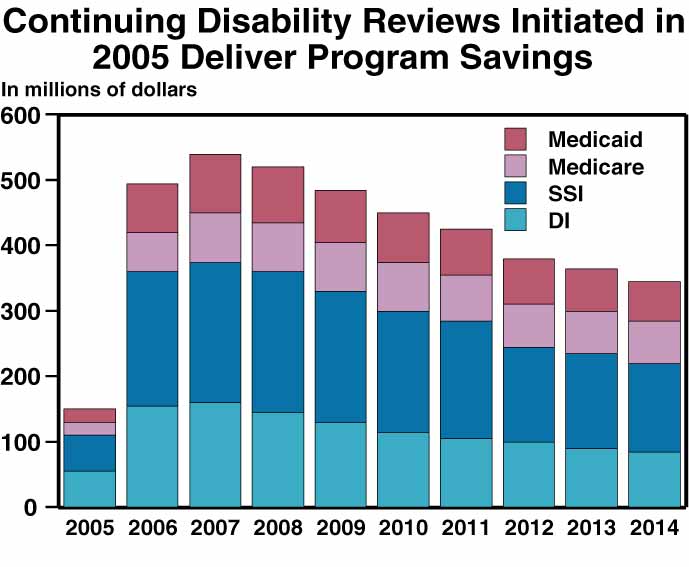 Skip Main Navigation
Skip Main Navigation
|
|||||||||||||||||||||||||||||||||||||||||||||||||||||||||||||||||||||||||||||||||||||||||||||||
SOCIAL SECURITY ADMINISTRATIONSince 2001, the Administration:
The President’s 2008 Budget:
FOCUSING ON THE NATION’S PRIORITIESStrengthening Social SecurityAs the President emphasized on the program’s anniversary: “For 70 years, Social Security has been a vital program and helped millions of America’s seniors in retirement. The Social Security system is sound for today’s seniors, but there is a hole in the safety net for younger workers. On this 70th anniversary, we renew our commitment to save and strengthen Social Security for our children and grandchildren, and keep the promise of Social Security for future generations.” Social Security needs to be strengthened so that younger workers paying into the system can continue to rely on Social Security. The program also needs to be reformed so that future scheduled benefit promises are aligned with the program’s available resources. Today, those promises in present value terms exceed the expected resources that will be available to pay for them under current law over the indefinite future by $13.4 trillion, according to the latest estimates by the Social Security actuaries. Social Security today operates on what is known as a “pay-as-you-go” basis, in which current worker payroll taxes are used immediately to pay for the benefits of current retirees and other beneficiaries. In 1950, there were about 16 workers for every retiree. Today, there are just more than three workers for every beneficiary, and by the time today’s 20-year-olds retire, that number will fall to two workers for every beneficiary. Furthermore, Social Security is paying greater benefits for longer periods of time as life expectancy increases, and the imminent retirement of the baby boom generation will result in added strain on the system. By 2017, the Social Security system will collect less in taxes than it pays in benefits and will shift into a permanent cash deficit that will grow every year. In 2040, Social Security will exhaust its Trust Fund assets and lack the resources to pay the benefits that have been promised and that seniors will be expecting. If Social Security’s finances are left unresolved, future changes would require today’s young workers to see their benefits sharply cut, their payroll taxes raised, or both. The President is committed to strengthening the Social Security system and has reiterated his commitment to a bipartisan reform process in which participants are encouraged to bring different options for strengthening Social Security to the table. The Budget supports the proposals the President has put forward to date. Under these proposals, Social Security would include voluntary personal accounts funded by a portion of the worker’s Social Security payroll taxes. The Budget includes the estimated impact from the creation of such personal accounts. In 2012, the first year of the accounts, contributions will be capped at four percent of Social Security taxable earnings up to a $1,300 limit, increasing by $100 each year through 2017. As part of a solution to restore the system to sustainable solvency, the President has also embraced the idea of indexing the future benefits of the highest wage workers to inflation while providing for a higher rate of benefit growth for lower-wage workers. Benefits for lower-wage workers would be tied to wage growth as under current law, ensuring that their benefits would grow faster than the poverty line. Progressive indexing coupled with voluntary personal retirement accounts will provide future seniors with real money and real security instead of the current system’s unfunded promises. Preventing Waste, Fraud, and Abuse by Improving Program IntegrityProgram integrity efforts are designed to ensure that only eligible individuals receive benefits, and that they receive the correct benefit. As part of these efforts, the Social Security Administration (SSA) reviews the eligibility status of Disability Insurance (DI) and Supplemental Security Income (SSI) recipients. Progress has been made on reducing waste, fraud, and abuse in these programs. However, it is estimated that in 2005, improper payments, representing both overpayments and underpayments, in the Old-Age and Survivors Insurance, DI, and SSI programs totaled $6.3 billion. The Budget increases funding for Continuing Disability Reviews (CDRs) and SSI redeterminations, which assess whether the beneficiary still meets the requirements of the DI and SSI programs. The President’s budgets have requested this funding since 2002, the last year SSA had dedicated funding for this program integrity effort. Without this funding, SSA was unable to fight waste, fraud, and abuse as aggressively as possible. It is estimated that SSA’s increased funding to fight fraud and abuse will save an additional $2 billion across multiple programs. SSA generates savings of $10 for each $1 spent on CDRs. SSA expects CDRs conducted in 2005 to yield more than $5 billion in program savings, including $4.2 billion in the first 10 years, as shown in the chart, and $1.3 billion after the 10-year window.
SSA is engaged in many other activities to improve payment accuracy. SSI redeterminations help ensure the SSI benefit amount is correct and yield savings of $7 for every $1 spent administering them. SSA is modifying its screening process for SSI redeterminations to more efficiently identify cases requiring a full review. SSA is also expanding a pilot study to conduct electronic matches with financial institutions to make sure that applicants for SSI do not have assets exceeding the SSI limits. In addition, SSA is developing easier ways for SSI recipients to report their wages, including expanded telephone wage reporting. Improving Disability InsuranceSince its inception in 1956, the Social Security DI program has provided vital disability insurance coverage and benefits to America’s workers. Over the past 50 years, DI has helped roughly 20 million disabled workers, as well as their dependents, cope with the loss of income due to severe disability. In 2006, SSA significantly revised the disability determination process to increase accuracy, consistency, and timeliness. The new process was rolled out in the Boston region in August 2006, and builds upon SSA’s electronic disability claims tool. Changes to the disability determination process will greatly improve the quality of service SSA provides to millions of disabled workers and their families. While the disability determination process has been placed on a sound course, the program’s fiscal health is a growing concern. DI outlays have grown as a percentage of all Federal budget outlays from about 2.1 percent in 1989 to an estimated 3.6 percent in 2007. The Budget projects DI outlays will continue to increase as a percentage of the Federal budget, along with escalating annual cash deficits. The 2008 Budget includes a proposal to highlight with a “funding warning” the escalating and persistent fiscal problems facing DI. If SSA’s actuaries project a negative DI cash flow that is more than 10 percent of program cost for four consecutive years in the upcoming 10 years, the Board of Trustees will issue the warning in the annual Trustees Report. Issuance of a DI funding warning would require the President to transmit to the Congress proposed legislation to respond to the warning within 15 days after the date of the next Budget submission; the Congress would then consider this legislation. The analysis of DI’s budgetary impact will safeguard an important source of disability insurance while promoting sound fiscal policy. Helping Identify Unauthorized WorkersSSA helps employers verify that employees have provided accurate Social Security Numbers and are authorized to work in the United States through several voluntary programs. SSA participated in 78 million employee verifications in calendar year 2006, up from 67 million in calendar year 2005. Employers in all 50 States may participate in the Basic Pilot program, an ongoing voluntary program in which SSA assists the Department of Homeland Security (DHS) in enabling employers to verify the employment eligibility of new hires. As of December 2006, DHS and SSA had signed agreements with over 12,000 employers, representing approximately 47,000 employer sites. Since October 2006, SSA has received an average of 200,000 Basic Pilot verification requests a month. Enhancing Service to the Public through Productivity GainsIn 2006, SSA made payments to more than 53 million people each month. Further, SSA served approximately 42 million visitors to its more than 1,300 field offices in communities across America, processed 3.8 million applications for retirement and survivors benefits, and processed 2.5 million applications for disability benefits. In addition, SSA handled more than 59 million 800–number transactions and processed more than 2.1 million electronic transactions, such as applying for benefits, changing direct deposit or address information, requesting replacement Medicare cards, and requesting proof of income letters. Based on the agency’s proven track record, the expected rate of improvement in productivity assumed for 2008 in the Budget is two percent. Increased productivity enables SSA to provide a wider variety of services with fewer resources than would otherwise be required. SSA has an impressive track record in increasing agency-wide productivity. From 2001 to 2006, productivity climbed an average of 2.5 percent per year, for a total gain of 13.1 percent since 2001. SSA continually evaluates its business processes and invests heavily in its information technology systems to ensure that these improvements continue.
1 The LAE account includes funding from the Hospital Insurance and Supplementary Medical Insurance trust funds for services that support the Medicare program, including implementation of Medicare Reform. 2 For 2006, the LAE base does not include a $10 million cash refund, which increased SSA’s budgetary resources, but did not increase SSA’s new budget authority. 3 In 2006, Treasury refunded the OASI and DI trust funds by $5,651 million due to overpayment of voluntary income tax witholding. This did not impact beneficiary payments. The mandatory outlay total does not include this refund. |
|||||||||||||||||||||||||||||||||||||||||||||||||||||||||||||||||||||||||||||||||||||||||||||||
|
|||||||||||||||||||||||||||||||||||||||||||||||||||||||||||||||||||||||||||||||||||||||||||||||
|
|
|||||||||||||||||||||||||||||||||||||||||||||||||||||||||||||||||||||||||||||||||||||||||||||||

